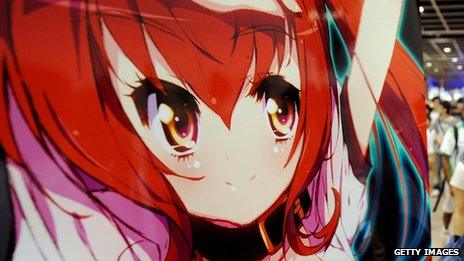Swedish manga cartoon translator cleared of child porn
- Published

A Swedish translator of Japanese-style manga comics has been cleared of child pornography charges in a case that has sparked debate about whether cartoon characters can be considered people.
Simon Lundstroem had appealed to the Supreme Court against his conviction for possessing 39 sexual images depicting young-looking characters drawn in manga style.
Manga is a hugely popular genre in Japan. There are magazines for children, adults and senior citizens, and titles targeted at special interest groups such as golfers, businessmen and new mothers.
"There's a lot of sex," says Fredrik Stroemberg, chairman of Sweden's cartoon association, Seriefraemjandet, "and a lot of violence." A small number of titles have explicit content.
Child pornography is illegal in Sweden but it was not clear whether the definition extended to cartoon characters.
Culture of 'cuteness'
The chief prosecutor in the case, Hedvig Trost, had argued in court that the ban was there to protect children "whether it is real children depicted or not", and that such images could be used to coerce them into taking part in sexual activities.
"Children should never be depicted in a sexual context, regardless of whether it is in a photograph or a drawing," she said.
The court ruled that all bar one of the images were fantasy figures and not depictions of real children.
While potentially offensive, the images posed a substantially lower risk of provoking abuse against children than realistic ones, the judges found.
They said it was important to recognise that manga cartoons are deeply rooted in Japanese culture.
The judges had heard evidence from Mr Stroemberg, called by the defence as an expert witness. He argued it would be a mistake to consider the characters as representations of children based on European standards.
"For a start, Asian people are just smaller," he told the BBC, "but also the Japanese have a concept of kawaii, which means cuteness.
"Kawaii is not just for kids; men and women are supposed to be small and cute too. It's a desirable characteristic that encompasses the whole of Japanese society, not just comics.
If you design houses, if you design household products, they're meant to be kawaii," he said.
"Making manga characters look smaller, cuter, younger, reflects a state of mind, and is not a statement of age."
Mr Stroemberg continued: "A character can be twice the height of another character being both of the same age, and that says that one of the characters is a villain and the other is a hero, because heroes are supposed to be small and cute, villains are tall and sharp.
"Saying that one character is big and one is small doesn't say that one is older than the other."
Free speech
One image was considered realistic enough to be treated separately and the judges said possession of it would ordinarily have been an offence.
But they cleared Simon Lundstroem on the grounds that the nature of his work justified his having the drawing in his large collection.
Freedom of speech campaigners will take heart from the judges' contention that criminalising the possession of such images would be an infringement of the freedom of speech and of information.
The chair of the Swedish Writers' Union, Mats Soederlund, had been concerned that Swedish law was at risk of "forbidding fantasies".
"To punish the possession of such drawings is a threat to the freedom of speech and art," he said.
It was also the verdict sought by Bjorn Sellstroem, of the child pornography unit of the Swedish police.
He had written to the Svenska Dagbladet newspaper to warn that investigating such cases was a dangerous waste of resources.
He said: "There's a risk that the focus will shift from combating pictures and films of real child abuse to a discussion of whether we will judge drawings of fantasy figures as child pornography or art.
"Let us not forget that it is children we must protect and not put imaginary figures on an equal footing with them."
- Published16 December 2011
- Published15 December 2010
- Published6 December 2010